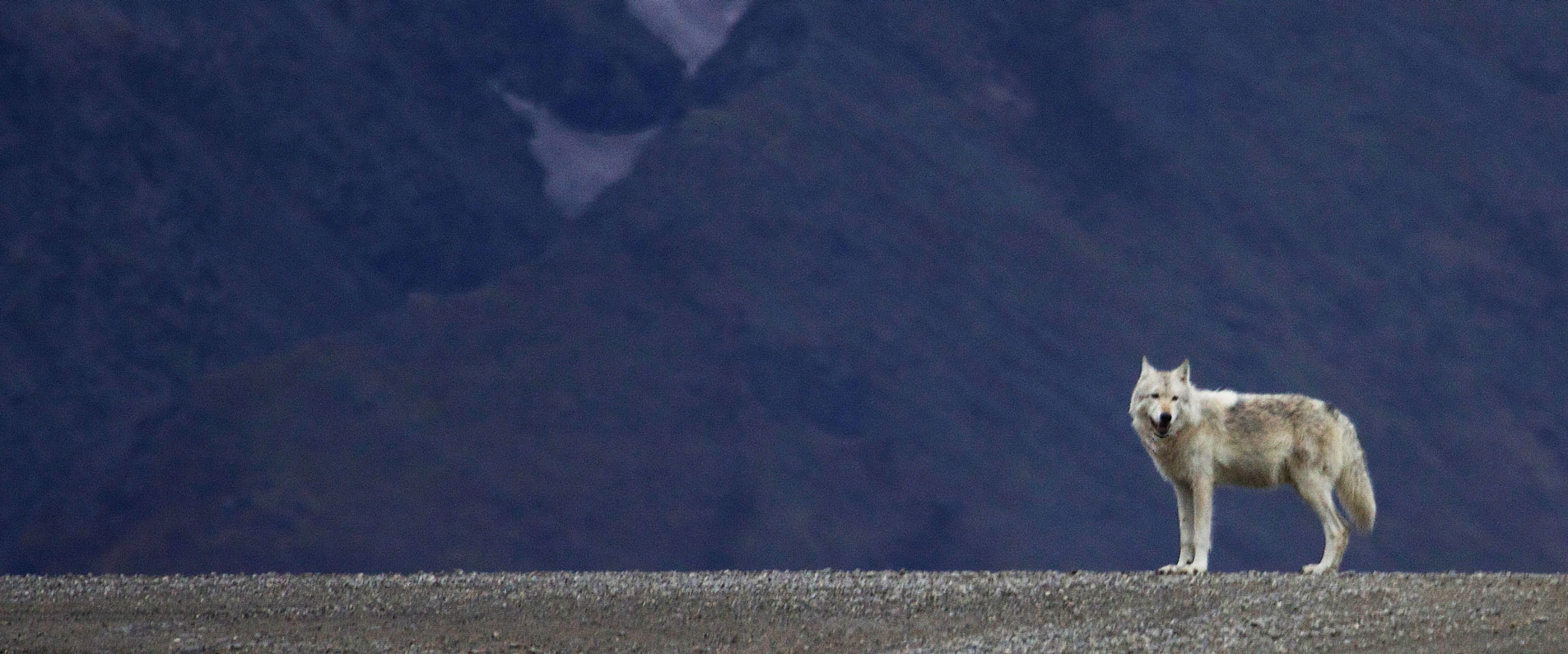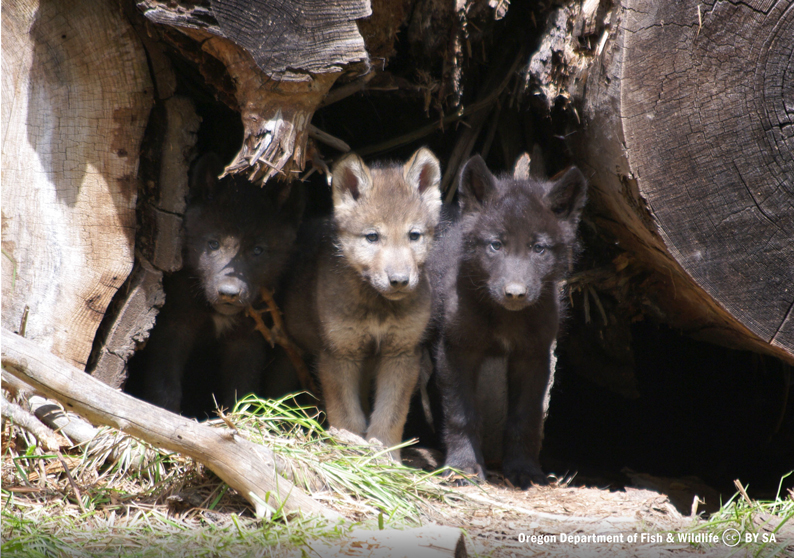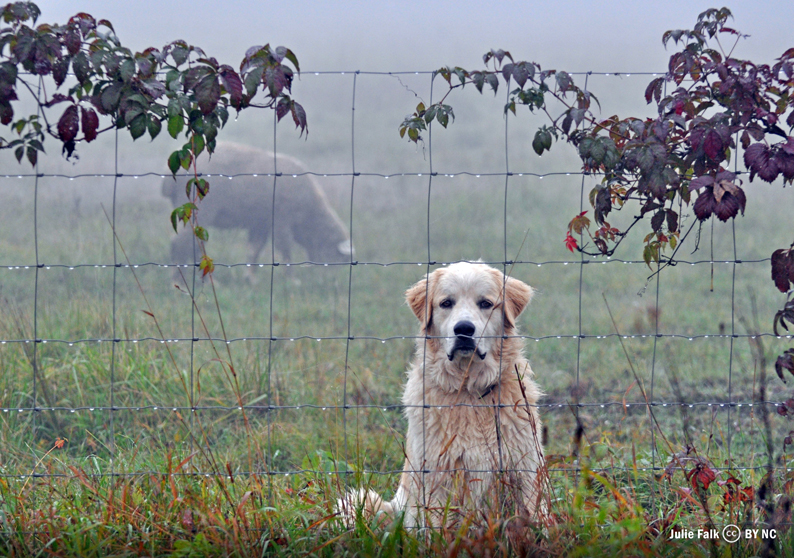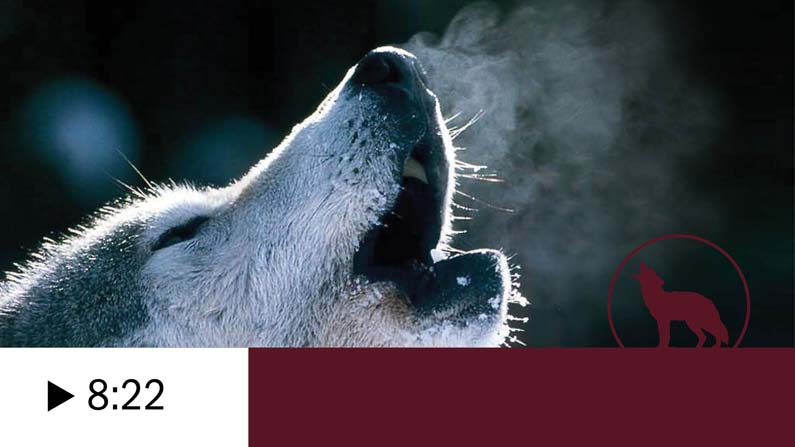WOLF ECOLOGY
The gray wolf has one of the greatest natural ranges of any living terrestrial mammal. Find out more…
THREATS TO WOLVES
As an apex predator, wolf mortality comes from humans and their activities. Find out more…
ECOLOGICAL ROLE
As with many large carnivores, wolves play a positive role in maintaining ecosystem health and integrity. Find out more…
COEXISTING
Non-lethal means to deter interactions, reduce livestock mortality and promote coexistence. Find out more…


ECOLOGY OF THE GRAY WOLF (CANIS LUPUS)
EVOLUTION
Gray wolves are members of the largest extant species in the Canidae family, which includes dogs, wolves, coyotes, jackals, and foxes. The fossil history leading to gray wolves’ origins tells a long and complex story of extinction and survival. Gray wolves emerged during a period of rapid environmental change and glacial activity that resulted in diminished species diversity. Genetic and morphological evidence points to gray wolves evolving during the Pliocene and early Pleistocene, from the same ancestral line of early, small canids (probably Canis lepophagus) that led to the evolution of coyotes (Nowak 2010). Wolf and coyote lines separated by the early Pleistocene, approximately 1.5 million years ago (Nowak 2010). The first wolf species likely evolved in North America, then crossed into Eurasia, where they evolved into gray wolves and crossed back into North America. Many species of wolves rose and fell before the Pleistocene yielded to our own era, the Holocene, around twelve thousand years ago (Derr 2011). According to genomic studies, modern wolves and dogs descended from the same ancestral wolf population extant between 30,000-20,000 years ago, but scientific understanding of wolf ancestry and dog domestication is evolving constantly (Bergström et al. 2022; Fan et al., 2016; Freedman et al., 2014; Skoglund et al., 2015).
DISTRIBUTION
Gray wolves have one of the most expansive natural ranges of any living terrestrial mammals (Nowak 1999). Their widespread success in many ecosystems across Eurasia and North America may be due to certain evolutionary adaptations. For example, wolves display behaviors that are rare among large carnivores, such as coordinated hunting in which pack members are constantly aware of one another’s spatial and temporal position, communication over distances, and the ability to adapt their hunting style to their prey (Derr 2011). These adaptations have made it easier for wolves to inhabit most ecosystems in the Northern Hemisphere (Derr 2011, Nowak 1999). Between 36-40 subspecies of gray wolves are dispersed around the world (Wilson & Reeder 2005). Unfortunately, some are now extinct (Eisenberg 2014). The global range of gray wolves has been reduced by over a quarter due to extermination campaigns and persecution that continue today in places where wolves are not protected (Wolf & Ripple 2017).
SOCIAL STRUCTURE
Gray wolves are sentient, self-aware and social animals, with distinct cultures and personalities (Dutcher, Dutcher & Manfull, 2013; Haber, 1996; Haber & Holleman, 2013; Packard 2003). As social animals, communication plays a big role in coordination, cooperation and relationship forming (Dutcher, Dutcher & Manfull, 2013; Haber & Holleman, 2013; Packard 2010). For example, studies have explored how howls are driven by emotional and cognitive factors, and suggest wolf howling varies based on the relationships between the sender and the recipient of the communication (Mazzini et al. 2013), and that wolves can tell each other apart through their howls (Palacios et al. 2015). The capacity for complex communication allows for cooperative hunting, defense of territory, and pup-rearing by breeding pairs and non-breeding individuals (Haber & Holleman, 2013).
Gray wolves are most often found in family groups (often called ‘packs’) consisting of an adult pair, their offspring, and occasionally relatives or immigrant individuals (Mech & Boitani 2010, Packard 2010). The leader of the family group is the female or male wolf who normally initiates activity, guides movements, and makes decisions. Although various models of wolf social structure based on linear or sex/age hierarchies have been proposed, current evidence suggests social structure is not based on aggressiveness and that most models of ‘rank’ oversimplify relationships, which could be more accurately interpreted as family relationships that may change with individuals’ behavior and mood (e.g., assertiveness and predisposition to escalate/reduce conflict; Packard 2010).
Regardless of social structure, the most dominant (i.e. assertive) pair usually mate. In established packs, the breeding pair are typically the parents of other pack members. Wolves have one breeding season a year, during winter (ordinarily between January and March depending on their geographic location), and females have a 60-63 day gestation period. Young wolves are whelped in the spring and reared in dens in rock crevices, hollow logs, overturned stumps, or burrows near water (Nowak 1999). There is generally an order for feeding, as the parents’ priority is to feed the youngest offspring first, and only then the older offspring are allowed to feed (Mech & Boitani 2010, Packard 2010). When the young become mobile, they move to rendezvous sites where their parents and other pack mates bring them food. Late in the fall they begin to join adults on hunts. Food availability promotes dispersal and limits family group size. Depending on such social dynamics, subordinate but sexually mature wolves may leave their natal families to find mates and establish new families.
APPEARANCE
Although wolves can show significant geographic polymorphism, the basic physical appearance of the gray wolf is much the same today as it was several thousand years ago. They have a muscular, deep-chested body, long slender limbs, a bushy tail, a long slender muzzle, and large erect ears. While their fur is usually long and light brown to gray with some black, some populations or individuals display coats of all black or all white. Gray wolves have four digits on the hind foot and five digits on the forefoot. Their head and body lengths range from 39 to 63 inches (99-160 cm) with the tail ranging from 13 to 22 inches (33-55 cm). On average, males are larger than females. Weight ranges from 44-176 lb (19-79 kg) for males and 39-121 lb (17-55 kg) for females (Nowak 1999). In the wild, few wolves live beyond four or five years, although females as old as 11 have been documented having litters (Fuller et al. 2010). Various environmental and genetic factors account for the differences in size, weight, and lifespans among subspecies.
DIET
Gray wolves are predominately predators of mammals larger than themselves (Nowak 1999, Mech & Peterson 2010), specializing on ungulates (hoofed mammals). Typical prey include deer, elk, caribou, bison, moose, muskox, and mountain sheep. In the Great Lakes, beavers make a significant portion of wolves’ diets (Gable et al. 2016). Although wolves were once thought to be obligate carnivores (eating only meat), they’re now considered to be facultative carnivores (primarily eating meat but can eat other food for subsistence). Recent studies show that blueberries are not only part of the summer diets of adult wolves in the Great Lakes, but that adults will regurgitate blueberries as a food source for pups as well (Homkes et al. 2020). A highly-developed sense of smell and sight aids them while hunting. Wolves use several strategies to find their prey, such as chance encounters or following their scent. Prey are usually captured through a strategy of stalking as closely as possible to the intended target and then giving chase. While the average walking speed of a gray wolf is 4 miles per hour (6.4 kph), their running gait is between 34 and 43 miles per hour (54.7-69.2 kph). Wolves’ hunting success is generally low measured by the number of hunts, and ranges from 10-49% contingent on various factors such as type of prey (and their anti-predator strategies), wolf motivation (time since last kill), weather and season (Mech & Peterson 2010). Most often, if a prey animal is not caught quickly, or is large and healthy and turns to confront the pack, the pack will give up the chase (Nowak 1999).
Feature photo: Howling Wolf by Fool4MyCanon via Creative Commons Above photo: Wolf Park Indiana by Serge Melki via Creative Commons
Learn more wolves and the science behind the issues facing this species in these articles:
Lawsuits Target War on Wolves and Grizzlies in the Northern Rockies
By Ryan Devereaux,
The Intercept
11.05.2022
Lawsuit Challenges Government’s Large-scale Wildlife Killing in Idaho
By The Wildlife News
2.11.2015
How to Kill a Wolf: An Undercover Report from the Idaho Coyote and Wolf Derby
By Christopher Ketcham
VICE 3.13.2014
The War Against Wolves and Wildlife: Time to Stop the Killing
By Camilla Fox,
The Huffington Post
10.27.13

WOLF MANAGEMENT
THREATS
Since wolves are apex predators, they experience little to no mortality from other species (other than perhaps parasites) in their natural environment. In some instances, wolves kill each other during territorial disputes and conflicts, mostly between packs. However, most wolf mortality comes from humans and their activities. Habitat fragmentation, urban sprawl and animal agriculture have played a pivotal role in the conflict between humans and wolves. Influences on gray wolf habitat and mortality include: habitat conversion for human uses, inadequate regulatory protections, authorized human hunting and trapping, illegal killing, killing or removal in response to conflicts with animal agriculture or ungulate hunting interests in wolf habitat, insufficient or ineffective law enforcement, and disease. These factors have affected wolf populations locally and globally by destroying habitat, direct killing of individuals, creating barriers to dispersal and migration, and reducing prey populations upon which wolves depend.
Killing wolves is linked to the break-up of family groups, with associated negative behavioral, physiological, social, ecological and evolutionary impacts. For example, Rutledge et al. (2010) point to the importance of maintaining stable wolf social structures for long-term fitness, and lists evidence of its importance for various ecological processes such as resource use (Sand et al. 2006; Stahler et al. 2006) and pup survival (Brainerd et al., 2008; Schmidt et al., 2008). Other studies have noted (e.g., Wallach et al. 2015 and Ordiz et al. 2013) that killing large carnivores, especially sustained killing, should be considered an evolutionary pressure that reduces the quality of traits and effects that allow wolves to fulfill their role as apex predators, along with other unexplored evolutionary implications. The cooperative behaviors that underlie wolves’ ecology and dynamics are hindered through the break-up of the family group, and such social instability highly constrains their ecological effects because “the pack is the apex predator, not the single individuals” (Wallach et al. 2009; see also Haber 1996). The strong scientific evidence for the negative impacts of killing on surviving wolves’ physiology and dynamics, such as effects on hormone regulation (e.g. Bryan et al. 2015, Pereira et al 2022) or pair/pack persistence (e.g., Brainerd et al. 2008, Cassidy et al. 2023) suggests a strong presumption against the implementation of lethal methods.
EVENTS LEADING TO THE CURRENT STATE OF GLOBAL GRAY WOLF POPULATIONS
(Cohn, 2011; Lute, et al, 2014; Nowak, 1999; USFWS, 2015; Young & Jackson, 1978):
Eighteenth Century:
- Increased pressure on global ecosystems, mass consumption of raw materials, pollution and habitat destruction, all begin to take shape as human population centers shift, grow, and migrate to meet the demands of modern society;
- Widespread government bounties for large carnivores in North America begin as people move westward;
- Last wolves in the British Isles are exterminated.
Nineteenth Century:
- Wolves are eliminated along the east coast and Ohio Valley of the United States;
- 1860-1885, widespread use of poisons such as strychnine becomes popular and are utilized extensively throughout North America on large carnivores to eradicate perceived threats to people and livestock.
Twentieth Century:
- Last wolves are eradicated in Canada south of the St. Lawrence River and the eastern U.S. except for Minnesota
- Wolves disappear from Western Europe and Japan;
- In the former Soviet Union, populations decline from 200,000 individuals to 50,000 following an intensive government eradication program;
- Wolves are exterminated in the western U.S. and Mexico;
- Large scale aerial hunting becomes popular across the globe;
- 1973-1974, Endangered Species Act provides regulatory protection for gray wolves making their recovery possible in the U.S.;
- 1988, wolf reintroduction program planning begins in U.S.;
- 1995, wolves are reintroduced into Yellowstone National Park, Wyoming, and Idaho;
- 1998, Mexican gray wolves are reintroduced in the Apache and Gila National Forest in Arizona and Mexico.
- 1982-1992, The Bern Convention and the European Union’s Habitats Directive were enacted, allowing for gray wolves’ recolonization of Europe
Twenty-first Century
- 2011-2012, U.S. Congress and USFWS delists gray wolves from Endangered Species Protection in the Northern Rocky Mountains (NRM), allowing renewed hunting
- 2012-2013, federal wolf management authority is largely turned over to state agencies in the NRM
- Between 2005 and 2014, the USFWS repeatedly attempted to remove federal protections for wolves nation-wide, while federal courts restored them (e.g., Dec 2014); various states such as Idaho, Montana, Minnesota and Wisconsin implemented recreational wolf-killing seasons while wolves were delisted
- Nov 2020, the federal government delisted gray wolves from the Endangered Species Act nationwide;
- Feb 2021, Wisconsin implemented a recreational wolf-killing season. A subsequent recreational wolf-killing season for November 2021 was struck down through a court injunction granted at the request of Project Coyote and other allied advocacy organizations.
- Feb 2022, a federal court restored protections for gray wolves under the Endangered Species Act nation-wide except in the NRM where the most egregious wolf hunting and trapping seasons exist

ECOLOGICAL ROLE OF WOLVES
As with many large carnivores, wolves play a positive role in maintaining ecological and evolutionary processes that benefit biodiversity and humans. Wolves provide critical top-down regulation of ecosystems, impacting many plants and animals through direct and indirect effects on the food web in a phenomenon referred to as a ‘trophic cascade’, and are generally considered a keystone species (Callan et al. 2013; Flagel et al. 2015; Licht et al, 2010; Painter & Tercek, 2020; Ripple et al. 2012).
For example, one study in a Canadian national park noted the negative effect of wolf exclusion by humans on various native species that might not otherwise be viewed as mutually dependent on each other. Researchers discovered that wolf exclusion decreased aspen recruitment, willow production, and increased willow and aspen browsing intensity. Beaver lodge density was negatively correlated to elk density, and elk browsing had an indirect negative effect on riparian songbird diversity and abundance (Hebblewhite, et al, 2005).
Another study notes that due to the absence of wolves, ungulates threaten vegetation across large portions of the United States. In contrast, the presence of wolves increases plant biomass and diversity (Callan et al. 2013; Flagel et al. 2015; Painter & Tercek, 2020; Ripple et al. 2012).
Wolves also impact the ecology and evolution of their wild prey. Wolves have primarily compensatory and weak additive effects on population dynamics of wild ungulates (Vucetich et al. 2005, Christianson & Creel 2014, Griffin et al. 2011, Brodie et al. 2013), given their focus on calves and older females with low reproductive value (Eberhardt et al. 2007, see also Wilmers et al. 2020). Compensatory effects mean that those ungulates would have died from other causes (e.g., disease, starvation, old age) in roughly the same time frame if wolves had not killed them. Additive mortality is additional death beyond those other natural causes. Wolves also have important positive impacts in: mitigating disease transmission in wild prey species, such as Chronic Wasting Disease and tuberculosis (Brandell et al. 2022, Tanner et al. 2019); suppressing and potentially eliminating diseases from closed populations (Wild et al. 2011); and acting as a selective pressure against genes associated with developing diseases, such as severe osteoarthritis (Hoy et al. 2022). The direct and indirect effects wolves have on their prey also help explain how the presence of wolves reduces deer-vehicle collisions in such places as Wisconsin, in particular through changes in deer behavior rather than a reduction in deer abundance (Gilbert et al. 2017, Raynor et al. 2021). In Wisconsin, researchers estimated that wolves reduce deer-vehicle collisions by 24%, saving residents $10.9 million a year and reducing human injuries and fatalities, mainly by causing deer to avoid roads (Raynor et al. 2021). Such studies also suggest that widespread and indiscriminate wolf-killing would negate the ecological benefits wolves bring. Overall, wolves help keep prey populations and ecosystems healthy.
Scientists also provide evidence that retaining wolves as part of good stewardship programs is a win-win for everyone. For instance, wolves had a beneficial economic impact on Yellowstone National Park, which saw increased visitation and ecotourism spending of $35 million in 2005 (Licht et al. 2010). A recent study estimated the total economic impact of wolf-related visitation at >$82 million in the Greater Yellowstone Ecosystem (RRC Associates 2022).


TIPS AND TOOLS FOR COEXISTENCE
Wolves’ predation on domesticated animals, especially commercially-bred cows and sheep, although minuscule from an industry perspective, is a source of controversy that has led to the institution of lethal means to address this conflict. However, recent advances in technology, scientific measures of effectiveness and new models of integrated ranching methods have given wolves a renewed chance of survival by offering more effective non-lethal means to deter interactions, reduce mortality of domesticated animals and promote coexistence.
The growing body of scientific studies points to lethal methods being less effective, unnecessary and less rigorously tested than non-lethal methods for mitigating conflicts. Within the past decade, several review studies from various international teams of scientists have concluded that non-lethal methods such as livestock guardian animals, barriers/enclosures (e.g., electrified fencing) and fladry (a visual deterrent made of a rope with hanging flags) are effective at preventing predation on domesticated animals. The same review studies have shown lethal methods to be some of the most ineffective (Treves et al. 2016) or counterproductive (Treves et al. 2016, Van Eeden et al. 2018) at preventing predation incidents. Other effective techniques include husbandry practices such as adjusting calving timing and location, increased range riding (humans on horseback) and low stress livestock handling that, when paired with enclosures, visual and auditory deterrents or guardian dogs, can be even more effective than lethal control for minimizing predation (Bruns et al., 2020, Davidson-Nelson & Gehring 2010, Gehring et al. 2010, Khorozyan and Waltert 2019, Lennox et al., 2018, Louchouarn and Treves 2023, Treves et al. 2016, Van Eeden et al. 2018, Wilson et al. 2018).
Other available measures include the removal of dead, sick, and diseased domesticated animals where carcasses might be easily scavenged by wolves, shed lambing (Shivik, 2006), and devices that disrupt predatory behaviors through light or sound stimuli (e.g., radio-activated guard boxes, Fox lights®; Eisenberg 2014, Shivik 2014, Shivik et al. 2003, Stone et al. 2017).
Scientists and government agencies concerned with the welfare of wolves can also monitor den sites and pack movements through radio-collar telemetry and remote camera data. This valuable technology allows ranchers to be notified when wolves are occupying a particular area, so ranchers can deploy non-lethal deterrents, although concerns remain over such information being used for illegal wolf-killing (Eisenberg 2014; LWW 2015).
Coexistence between humans and wolves presents many challenges requiring changes in long-held beliefs, values, and practices with regard to animal agriculture in wolf-occupied areas. Many resources and organizations, such as our Ranching With Wildlife Program, now exist to educate and assist ranchers with evolving techniques that will keep their animals safe by using predator-friendly management tools that deter attacks.

LITERATURE CITED
Bergström, A., Stanton, D. W. G., Taron, U. H., Frantz, L., Sinding, M. H. S., Ersmark, E., Pfrengle, S., Cassatt-Johnstone, M., Lebrasseur, O., Girdland-Flink, L., Fernandes, D. M., Ollivier, M., Speidel, L., Gopalakrishnan, S., Westbury, M. V., Ramos-Madrigal, J., Feuerborn, T. R., Reiter, E., Gretzinger, J., … Skoglund, P. (2022). Grey wolf genomic history reveals a dual ancestry of dogs. Nature, 607(7918), 313–320.
Brandell, E. E., Cross, P. C., Smith, D. W., Rogers, W., Galloway, N. L., MacNulty, D. R., Stahler, D. R., Treanor, J., & Hudson, P. J. (2022). Examination of the interaction between age-specific predation and chronic disease in the Greater Yellowstone Ecosystem. Journal of Animal Ecology, 91(7), 1373–1384.
Brainerd, S. M., Andrén, H., Bangs, E. E., Bradley, E. H., Fontaine, J. A., Hall, W., Iliopoulos, Y., Jimenez, M. D., Jozwiak, E. A., Liberg, O., Mack, C. M., Meier, T. J., Niemeyer, C. C., Pedersen, H. C., Sand, H., Schultz, R. N., Smith, D. W., Wabakken, P., & Wydeven, A. P. (2008). The effects of breeder loss on wolves. The Journal of Wildlife Management, 72(1), 89–98.
Brodie, J., Johnson, H., Mitchell, M., Zager, P., Proffitt, K., Hebblewhite, M., Kauffman, M., Johnson, B., Bissonette, J., Bishop, C., Gude, J., Herbert, J., Hersey, K., Hurley, M., Lukacs, P. M., Mccorquodale, S., Mcintire, E., Nowak, J., Sawyer, H., … White, P. J. (2013). Relative influence of human harvest, carnivores, and weather on adult female elk survival across western North America. Journal of Applied Ecology, 50(2), 295–305.
Bruns, A., Waltert, M., & Khorozyan, I. (2020). The effectiveness of livestock protection measures against wolves ( Canis lupus ) and implications for their co-existence with humans. Global Ecology and Conservation, 21, e00868.
Bryan, H. M., Smits, J. E. G., Koren, L., Paquet, P. C., Wynne‐Edwards, K. E., & Musiani, M. (2015). Heavily hunted wolves have higher stress and reproductive steroids than wolves with lower hunting pressure. Functional Ecology, 29(3), 347–356.
Callan, R., Nibbelink, N. P., Rooney, T. P., Wiedenhoeft, J. E., & Wydeven, A. P. (2013). Recolonizing wolves trigger a trophic cascade in Wisconsin (USA). Journal of Ecology, 101(4), 837–845.
Cassidy, K. A., Borg, B. L., Klauder, K. J., Sorum, M. S., Thomas-, R., Dewey, S. R., Stephenson, J. A., Stahler, D. R., Gable, T. D., Bump, J. K., Homkes, A. T., Windels, S. K., & Smith, D. W. (2023). Human- caused mortality triggers pack instability in gray wolves. Frontiers in Ecology and the Environment, 1–7.
Cohn, J.P. (2011). Wildlife Groups Opposing Congressional Delisting of Gray Wolf. Bioscience, 61(8)
Christianson, D., & Creel, S. (2014). Ecosystem scale declines in elk recruitment and population growth with wolf colonization: A before-after-control-impact approach. PLoS ONE, 9(7).
Davidson-Nelson, S. J., & Gehring, T. M. (2010). Testing fladry as a nonlethal management tool for wolves and coyotes in Michigan. Human–Wildlife Interactions, 4, 87–94.
Derr, M. (2011). How The Dog Became The Dog: From Wolves To Our Best Friends. New York: Overlook Duckworth.
Dutcher, J., Dutcher, J., & Manfull, J. (2013). The hidden life of wolves. National Geographic Books.
Eberhardt, L. L., White, P. J., Garrott, R. A., & Houston, D. B. (2007). A seventy‐year history of trends in Yellowstone’s northern elk herd. The Journal of wildlife management, 71(2), 594-602.
Eisenberg, C. (2014). The Carnivore Way: Coexisting With and Conserving North America’s Predators. Washington: Island Press.
Eklund, A., López-Bao, J. V., Tourani, M., Chapron, G., & Frank, J. (2017) Limited evidence on the effectiveness of interventions to reduce livestock predation by large carnivores. Scientific Reports, 7(1), 2097.
Epstein, Y. (2013). Population-Based Species Management Across Legal Boundaries: The Bern Convention, Habitats Directive and the Gray Wolf in Scandinavia. The Georgetown International Environmental Law Review, 25(549).
Fan, Z., Silva, P., Gronau, I., Wang, S., Armero, A. S., Schweizer, R. M., Ramirez, O., Pollinger, J., Galaverni, M., Ortega Del-Vecchyo, D., Du, L., Zhang, W., Zhang, Z., Xing, J., Vilà, C., Marques-Bonet, T., Godinho, R., Yue, B., Wayne, R. K. (2016). Worldwide patterns of genomic variation and admixture in gray wolves. Genome Research. 26 (2): 163–173.
Flagel, D. G., Belovsky, G. E., & Beyer, D. E. (2016). Natural and experimental tests of trophic cascades: gray wolves and white-tailed deer in a Great Lakes forest. Oecologia, 180(4), 1183–1194.
Freedman, A. H., Gronau, I., Schweizer, R. M., Ortega-Del Vecchyo, D., Han, E., et al. (2014). Genome Sequencing Highlights the Dynamic Early History of Dogs. PLOS Genetics. 10 (1). E1004016.
Fuller, T. K., Mech, L. D., & Cochrane, J. F. (2010). Wolf population dynamics. In D. Mech & L. Boitani (Eds.), Wolves: Behavior, Ecology and Conservation (pp. 161–191). The University of Chicago Press.
Gable, T. D., Windels, S. K., Bruggink, J. G., & Homkes, A. T. (2016). Where and how wolves (Canis lupus) kill beavers (Castor canadensis). PLoS One, 11(12), e0165537.
Gehring, T. M., VerCauteren, K. C., Provost, M. L., & Cellar, A. C. (2010). Utility of livestock-protection dogs for deterring wildlife from cattle farms. Wildlife Research, 37(8), 715–721.
Gilbert, S.L., Sivy, K.J., Pozzanghera, C.B., Dubour, A., Overduijn, K., Smith, M.M., et al. (2017) Socioeconomic Benefits of Large Carnivore Recolonization Through Reduced Wildlife-Vehicle Collisions. Conservation Letters, 10, 431–439.
Griffin, K. A., Hebblewhite, M., Robinson, H. S., Zager, P., Barber-Meyer, S. M., Christianson, D., Creel, S., Harris, N. C., Hurley, M. A., Jackson, D. H., Johnson, B. K., Myers, W. L., Raithel, J. D., Schlegel, M., Smith, B. L., White, C., & White, P. J. (2011). Neonatal mortality of elk driven by climate, predator phenology and predator community composition. Journal of Animal Ecology, 80(6), 1246–1257.
Haber, G. C. (1996). Biological, Conservation, and Ethical Implications of Exploiting and Controlling Wolves. Conservation Biology, 10(4), 1068–1081.
Haber, G., & Holleman, M. (2013). Among Wolves. University of Alaska Press Fairbanks.
Hebblewhite, M., White, C.A., Nietvelt, C.G., McKenzie, J.A., Hurd, T.E., Fryxell, J.M., Bayley, S.E., Paquet, P.C. (2005). Human Activity Mediates a Trophic Cascade Caused by Wolves. Ecology, 86 (8), 2135-2144
HOME: LWW – Living with Wolves. (n.d.). Retrieved April 12, 2015, from https://livingwithwolves.org/
Homkes, A. T., Gable, T. D., Windles, S. K., & Bump, J. K. (2020). Berry Important ? Wolf Provisions Pups with Berries in Northern Minnesota. Wildlife Society Bulletin, 44(1), 221–223.
Hoy, S. R., Vucetich, J. A., & Peterson, R. O. (2022). The Role of Wolves in Regulating a Chronic Non-communicable Disease, Osteoarthritis, in Prey Populations. Frontiers in Ecology and Evolution, 10(April), 1–9.
Khorozyan, I., & Waltert, M. (2019). How long do anti-predator interventions remain effective? Patterns, thresholds and uncertainty. Royal Society Open Science, 6(190826).
Lennox, R. J., Gallagher, A. J., Ritchie, E. G., & Cooke, S. J. (2018). Evaluating the efficacy of predator removal in a conflict-prone world. Biological Conservation, 224, 277–289.
Licht, D.S., Millspaugh, J.J.,Kunkel, K.E., Kochanny C.O., Peterson, R.O. (2010). Using Small Populations of Wolves for Ecosystem Restoration and Stewardship. BioScience, 60 (2).
Lopez, B. (1978). Of wolves and men. Scribner.
Louchouarn, N., Santiago-Ávila, F. J., Parsons, D. R., & Treves, A. (2021). Evaluating how lethal management affects poaching of Mexican wolves. Royal Society Open Science, 8(200330).
Lute, M.L., Bump, A., Gore, M.L. (2014). Identity-Driven Differences in Stakeholder Concerns About Hunting Wolves. Public Library of Science (PLoS) One, 10 (1371)
Northeast Wolf Coalition. (n.d.). Retrieved April 12, 2015, from http://www.northeastwolf.org/
Mazzini, F., Townsend, S. W., Virányi, Z., & Range, F. (2013). Wolf Howling Is Mediated by Relationship Quality Rather Than Underlying Emotional Stress. Current Biology, 23, 1677–1680. https://doi.org/10.1016/j.cub.2013.06.066
Mech, L. David, and Luigi Boitani, eds. Wolves: behavior, ecology, and conservation. University of Chicago Press, 2010.
Mech, L. D., & Peterson, R. O. (2010). Wolf-prey relations. In L. D. Mech & L. Boitani (Eds.), Wolves: Behavior, Ecology and Conservation (pp. 239–258). University of Chicago Press.
Miller, J. R. B., Stoner, K. J., Cejtin, M. R., Meyer, T. K., Middleton, A. D., & Schmitz, O. J. (2016). Effectiveness of contemporary techniques for reducing livestock depredations by large carnivores. Wildlife Society Bulletin.
Nowak, R. (1999). Walker’s Mammals Of The World (6th ed.). Baltimore: Johns Hopkins University Press.
Nowak, R. M. (2010). 9. Wolf Evolution and Taxonomy. In L. D. Mech & L. Boitani (Eds.), Wolves: Behavior, Ecology and Conservation (pp. 239–258). University of Chicago Press.
Ordiz, A., Bischof, R., & Swenson, J. E. (2013). Saving large carnivores, but losing the apex predator? Biological Conservation, 168, 128–133.
Packard, J. M. (2010). Wolf Behavior: Reproductive, Social, and Intelligent. In L. D. Mech & L. Boitani (Eds.), Wolves: Behavior, ecology, and conservation (pp. 35–65). University of Chicago Press.
Painter, L. E., & Tercek, M. T. (2020). Tall willow thickets return to northern Yellowstone. Ecosphere, 11(5).
Palacios, V., Font, E., Márquez, R., & Carazo, P. (2015). Recognition of familiarity on the basis of howls: A playback experiment in a captive group of wolves. Behaviour, 152(5), 593–614. https://doi.org/10.1163/1568539X-00003244
Pereira, P., Fandos Esteruelas, N., Nakamura, M., Rio-Maior, H., Krofel, M., Di Blasio, A., Zoppi, S., Robetto, S., Llaneza, L., García, E., Oleaga, Á., López-Bao, J. V., Fayos Martinez, M., Stavenow, J., Ågren, E. O., Álvares, F., & Santos, N. (2022). Hair cortisol concentration reflects the life cycle and management of grey wolves across four European populations. Scientific Reports, 12(1), 5697.
Raynor, J.L., Grainger, C.A. & Parker, D.P. (2021) Wolves make roadways safer, generating large economic returns to predator conservation. Proceedings of the National Academy of Sciences, 118, e2023251118.
Ripple, W. J., & Beschta, R. L. (2012). Trophic cascades in Yellowstone: The first 15years after wolf reintroduction. Biological Conservation, 145(1), 205–213.
RRC Associates (2022). Greater Yellowstone Wildlife- Related Activity Valuation Study. Institute for Tourism and Recreation Research, University of Montana
Rutledge, L. Y., Patterson, B. R., Mills, K. J., Loveless, K. M., Murray, D. L., & White, B. N. (2010). Protection from harvesting restores the natural social structure of eastern wolf packs. Biological Conservation, 143(2), 332–339.
Sand, H., Wikenros, C., Wabakken, P., & Liberg, O. (2006). Effects of hunting group size, snow depth and age on the success of wolves hunting moose. Animal Behaviour, 72, 781–789.
Santiago-Ávila, F. J., Lynn, W. S., & Treves, A. (2018). Inappropriate consideration of animal interests in predator management: Towards a comprehensive moral code. In T. Hovardas (Ed.), Large Carnivore Conservation and Management: Human Dimensions and Governance (pp. 227–251). Routledge.
Schmidt, K., Jędrzejewski, W., Theuerkauf, J., Kowalczyk, R., Okarma, H., & Jędrzejewska, B. (2008). Reproductive behaviour of wild-living wolves in Białowieża Primeval Forest (Poland). Journal of Ethology, 26(1), 69–78.
Shivik, J. (2014). The Predator Paradox: Ending the War with Wolves, Bears, Cougars, and Coyotes. Beacon Press.
Shivik, J.A., (2006). Tools for the Edge: What’s New for Conserving Carnivores. BioScience, 56 (3), 253-259.
Shivik, J.A., Treves, A., Callahan, P. (2003). Nonlethal Techniques for Managing Predation: Primary and Secondary Repellents. Conservation Biology, 17 (6), 1531-1537.
Skoglund, P., Ersmark, E., Palkopoulou, E., Dalén, L. (2015). Ancient Wolf Genome Reveals an Early Divergence of Domestic Dog Ancestors and Admixture into High-Latitude Breeds. Current Biology. 25 (11): 1515–1519.
Stahler, D. R., Smith, D. W., & Guernsey, D. S. (2006). Foraging and feeding ecology of the gray wolf (Canis lupus): Lessons from Yellowstone National Park, Wyoming, USA. Journal of Nutrition, 136, 1923S-1926S.
Stone, S. A., Breck, S. W., Timberlake, J., Haswell, P. M., Najera, F., Bean, B. S., & Thornhill, D. J. (2017). Adaptive use of nonlethal strategies for minimizing Wolf-sheep conflict in Idaho. Journal of Mammalogy.
Tanner, E., White, A., Acevedo, P., Balseiro, A., Marcos, J., & Gortázar, C. (2019). Wolves contribute to disease control in a multi-host system. Scientific Reports, 9(7940), 1–12.
Treves, A., Krofel, M., & McManus, J. (2016). Predator control should not be a shot in the dark. Frontiers in Ecology and the Environment. 14(7), 380–388.
Treves, A., Santiago-Ávila, F. J., & Putrevu, K. (2021). Quantifying the effects of delisting wolves after the first state began lethal management. PeerJ, 9(e11666), 1–16.
Van Eeden, L. M., Eklund, A., Miller, J. R. B. B., Lopez-Bao, J. V, Chapron, G., Cejtin, M. R., Crowther, M. S., Dickman, R., Frank, J., Krofel, M., Macdonald, D. W., Mcmanus, J., Meyer, T. K., Middleton, A. D., Newsome, T. M., Ripple, W. J., Ritchie, E. G., Schmitz, O. J., Stoner, K. J., … Treves, A. (2018). Carnivore conservation needs evidence-based livestock protection. PLoS Biology, 16(9), 1–8.
Vucetich, J. A., Smith, D. W. & Stahler, D. R. (2005) Influence of harvest, climate and wolf predation on Yellowstone elk, 1961-2004. Oikos, 111, 259-270.
Wallach, A., Ritchie, E., Read, J., & O’Neill, A. (2009). More than mere numbers: The impact of lethal control on the social stability of a top-order predator. PLoS One, 4(9).
Wallach, A. D., Izhaki, I., Toms, J. D., Ripple, W. J., & Shanas, U. (2015). What is an apex predator? Oikos, n/a-n/a. https://doi.org/10.1111/oik.01977
Western Gray Wolf: U.S. Fish and Wildlife Service. (n.d.). Retrieved April 12, 2015, from http://www.fws.gov/mountain-prairie/species/mammals/wolf
Wild, M. A., Hobbs, N. T., Graham, M. S., & Miller, M. W. (2011). The role of predation in disease control: A comparison of selective and nonselective removal on prion disease dynamics in deer. Journal of Wildlife Diseases, 47(1), 78–93.
Wilmers, C. C., Metz, M. C., Stahler, D. R., Kohl, M. T., Geremia, C., & Smith, D. W. (2020). How climate impacts the composition of wolf-killed elk in northern Yellowstone National Park. Journal of Animal Ecology, 89(6), 1511–1519.
Wilson, D. E., & Reeder, D. M. (Eds.). (2005). Mammal species of the world: a taxonomic and geographic reference (Vol. 1). JHU press.
Wolf, C., & Ripple, W. J. (2017). Range contractions of the world’s large carnivores. Royal Society Open Science, 4(7).
Young, S., & Jackson, H. (1978). The Clever Coyote. Lincoln: University of Nebraska Press.


